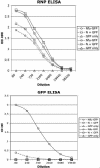Rabies virus nucleoprotein as a carrier for foreign antigens
- PMID: 15197258
- PMCID: PMC438989
- DOI: 10.1073/pnas.0403060101
Rabies virus nucleoprotein as a carrier for foreign antigens
Abstract
Rabies virus (RV) nucleoprotein (N) tightly encapsidates the genomic and antigenomic RNA of RV to form the viral ribonucleoprotein (RNP) complex. Antigens, such as N, presented in a highly organized structure are sufficient and even desirable to activate B cells to proliferate and produce antibodies. In addition to activating B cells to proliferate, it has been shown that RV N in the RNP complex induces potent T helper cell responses resulting in long-lasting and strong humoral immune responses against RV. The possibility to systematically incorporate foreign genes into the genome of RV and produce a recombinant virus allows us to examine whether the immunogenicity of foreign antigens can be enhanced by incorporation into the RV RNP structure. To test this hypothesis we constructed a recombinant RV expressing a RV N-GFP fusion protein. The chimeric N-GFP fusion protein was efficiently expressed and incorporated into RV RNP and virions. Moreover, the recombinant RNP induces a strong humoral immune response against GFP in mice. In contrast, mice inoculated with GFP alone or a combination of wild-type RV RNPs and GFP did not trigger any GFP-specific humoral responses using the same immunization schedule. These data indicate the usefulness of RV-based vectors as killed vaccines against other infectious diseases.
Figures





References
-
- Wagner, R. R. & Rose, J. K. (1996) in Fields Virology, ed. Knipe, D. M. (Lippincott, New York), Vol. 1, pp. 1121-1136.
-
- Conzelmann, K. K., Cox, J. H., Schneider, L. G. & Thiel, H. J. (1990) Virology 175, 485-499. - PubMed
-
- Tordo, N. & Kouknetzoff, A. (1993) Onderstepoort J. Vet. Res. 60, 263-269. - PubMed
-
- Tordo, N., Poch, O., Ermine, A., Keith, G. & Rougeon, F. (1988) Virology 165, 565-576. - PubMed
Publication types
MeSH terms
Substances
Grants and funding
LinkOut - more resources
Full Text Sources
Other Literature Sources

